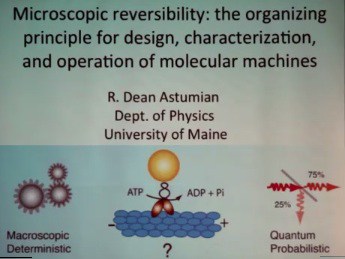
A select set of videos from the 2013 Foresight Technical Conference: Illuminating Atomic Precision, held January 11-13, 2013 in Palo Alto, have been made available on vimeo. Videos have been posted of those presentations for which the speakers have consented. Other presentations contained confidential information and will not be posted.
The second speaker at the Molecular Machines and Non-Equilibrium Processes session, the winner of the 2011 Feynman Prize for Theoretical work, Dean Astumian, presented his prize-winning work “Microscopic Reversibility: The Organizing Principle for Molecular Machines” biography and abstract, https://vimeo.com/63008846 – video length 42:12. He addressed how we should think about molecular machines, and in particular, molecular machines inspired by biology, which operate in water at slightly more than room temperature. A molecule called kinesin converts chemical energy from the hydrolysis of ATP (adenosine triphosphate) to walk in one direction on a molecular track called a microtubule. We could try to think of it in terms of a macroscopic deterministic picture, as in mechanics, or we could think of it in probabilistic terms more consistent with chemistry.
To highlight the differences between the mechanical and chemical perspectives, let us start with a small macroscopic motor. One challenge Richard Feynman issued in his 1959 talk “There’s Plenty of Room at the Bottom” was to build an electric motor 1/64th of an inch on a side. This challenge was met less than a year later by an engineer named William McClellan, a clockmaker who made components as small as he could by hand, so that the motor was an ordinary macroscopic motor. Like any other macroscopic motor, it does absolutely nothing in the absence of an energy supply; it is sitting there in static equilibrium. The organizing principle for macroscopic motors is cause and effect. We design a mechanism such that we put in a force at one point, which turns a gear, etc, and out comes a desired motion.
A molecular motor, in contrast, is 50,000 times smaller and is sitting in water at dynamic equilibrium. At chemical equilibrium this motor is very active: stepping forward, stepping backward, hydrolyzing ATP, synthesizing ATP, etc. All of the motions possible to this machine are present in dynamic equilibrium—the equilibrium with which we are familiar from chemistry. Every possible forward motion is compensated by the microscopic reverse of that motion. Every time it hydrolyzes ATP and takes a step in one direction, it is just as likely to synthesize ATP and take a step in the other direction. This understanding opens up to us a very different way of looking at these microscopic motors to understand how their operating principle might work. That is to use our chemical energy not to cause the motion that we want, but to prevent the motions that we do not want, so that what remains will be the desired movement.
Prof. Astumian addressed what we mean by the terms “equilibrium” and “non-equilibrium”. At the turn of the past century, Marian Smoluchowski considered two different colloidal suspensions in cylinders: the first one in non-equilibrium in which all of the particles were near the top of the cylinder, and the other near barometric equilibrium in which the force of gravity had caused more particles to collect near the bottom of the cylinder. Considering one particle in comparable positions near the top of both cylinders, he asked what the difference was between the forces experienced by the one far from equilibrium and the one near equilibrium, and realized that the answer was “nothing” (except in the single case of a particle resting on the bottom of the cylinder, which is therefore subject to a boundary condition). Thus, the probability to go up in a gravitational field is not zero; going up is accomplished by borrowing energy from the thermal bath and storing it in the potential energy of the particle. Thus there are a lot of energy storing trajectories available, and if we could keep them from coming back down, we would have a mechanism for storing energy and doing work. These considerations bring us to “Feynman’s ratchet” (also known as Brownian ratchet or Feynman-Smoluchowski ratchet).
Feynman was thinking about one-way devices and realized that if you had a ratchet and pawl connected by an axle to a paddle wheel such that the ratchet cannot turn clockwise but it can turn counterclockwise, then should not the collisions of molecules with the paddle wheel move the ratchet counterclockwise? The answer is “no”, because the spring to which the pawl is attached is also molecular so it is also moving up and down. If the spring and gas hitting the paddle wheel are at the same temperature, the ratchet will thus move randomly back and forth instead of in one direction. If, however, Feynman pointed out, the gas is hotter than the spring, then you do get directed motion in the counterclockwise direction. If the spring is hotter than the gas hitting the paddle wheel, clockwise motion results.
However, lots of molecules (proteins) act like springs, and by binding a small ligand to the protein, the equilibrium length of the spring can be changed, as can the spring constant. The spring therefore offers a target for chemical modification. What happens if there is a potential energy that is changing in time? Can the energy of modulation be used to drive directed transport up hill? Lars Onsager and his student Stephan Machlup derived a function to describe the dynamics of a continuous stochastic process, that is, in the presence of thermal noise. Allosteric change in the shape of a protein can be used to prevent backward motion so that only forward motion can occur.
The Nature Nanotechnology paper cited in Prof. Astumian’s final slide, which provides further discussion of an “information ratchet” and microscopic reversibility, has been made available by Prof. Astumian on Research Gate “Microscopic reversibility as the organizing principle of molecular machines” [Nature Nanotehnology 7: 684-688 (2012)].
—James Lewis, PhD
